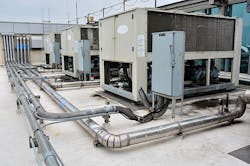Major agreement reached on commercial AC/furnace regulations
ARLINGTON, VA. — The Commercial Packaged Air Conditioners and the Commercial Warm Air Furnaces Working Group have reached consensus and provided recommendations to the Department of Energy for efficiency standards, test procedures and metrics.
The agreement is the result of formal negotiated rulemaking, lead by the DOE, which industry and advocates requested back on April 1. Seventeen stakeholders formed the negotiating committee, including equipment manufacturers (such as Goodman, Rheem, Lennox and others), contractors and installers, utilities, conservation groups and others.
The new standards will save almost 15 quadrillion BTU (quads) of energy from more efficient equipment shipped over the next 30 years. To put the agreement in perspective, many DOE standards lead to savings of 1 quad or less. 15 quads equals almost as much energy as in all the coal burned in the United States to generate electricity in a year.
Energy savings generated by the proposed standards will also lead to savings on energy bills — almost $50 billion over the life of the standards — and avoid 815 million metric tons of carbon pollution over the life of the rules. Given that most commercial AC and furnace units last for close to 20 years, improved efficiency will save money for commercial building owners over the long term.
The agreement includes standards for commercial rooftop air conditioners (also known as rooftop units, RTUs or commercial unitary equipment) that are found on over half the commercial buildings in the U.S. Also included are updated standards for warm air furnaces, which can be stand-alone commercial furnaces or can be used in conjunction with RTUs.
“By every measure, this is the biggest efficiency standards rulemaking in the DOE’s history,” said Steven Nadel, executive director of the American Council for an Energy-Efficient Economy.
The Air-Conditioning, Heating and Refrigeration Institute (AHRI) applauded the ruling.
“Negotiated rulemaking is our preferred method for establishing energy conservation standards for covered projects and equipment,” said AHRI President and CEO Stephen Yurek. “Bringing stakeholders together to develop a rule that is both effective and achievable is the best way to ensure that our members’ products and equipment provide consumers and businesses with comfort, safety and productivity while helping our nation achieve its energy reduction targets.”
U.S. Green Building Council Announces New Alignment with CALGreen
Rheem, an industry member of the ASRAC Working Group, is pleased with the group’s efforts and results. “I’m proud that we reached full committee consensus and the ASRAC approved our recommendations,” said Karen Meyers, Rheem’s vice president of Governmental Affairs.
“The Working Group’s standards will lead to tremendous energy savings,” Meyers continued. “In the near future we expect the DOE to issue a supplemental rulemaking that will reflect the Working Group’s agreement. Then, the first phase of the standards will be implemented in 2018 with the second phase coming in 2023.
“At Rheem we’ll soon begin developing next-generation commercial products that will meet the new standards,” added Meyer. “We’ll use our 360 degree+1 design philosophy, which tasks engineers with carefully considering what it takes to install and service commercial products, and then making improvements based upon their findings.”
By 2018 the standards would require new RTUs to be approximately 10 percent more efficient starting Jan. 1. The standards in this first stage are equivalent to the levels published in ASHRAE 90.1-2013 (the national model building code that covers this equipment).
By 2023, RTUs manufactured by Jan. 1 would be required to be 25 percent to 30 percent more efficient than today’s models depending on the size of the unit. 2023 will also see updated standards for commercial furnaces that would require thermal efficiencies of at least 81 percent for gas furnaces and 82 percent for oil furnaces.
AC standards would be based on the IEER (Integrated Energy Efficiency Ratio) metric, which captures the air conditioner’s performance over a range of operating conditions.
The next step in the process is for DOE to propose the actual standards based on this agreement. Those standards should be completed by the end of the year. Given the broad group of stakeholders represented in the negotiations, little opposition is expected to these final standards.
The Working Group was established under the Appliance Standards and Rulemaking Federal Advisory Committee (ASRAC) in accordance with the Federal Advisory Committee Act and the Negotiated Rulemaking Act.
Specifically, the group was tasked with addressing rules for the energy efficiency of commercial package air conditioners and heat pumps (specifically, air-cooled with rated cooling capacities greater than or equal to 65,000 Btuh and less than 760,000 Btuh split and package AC and HP) and commercial warm air furnaces, as authorized by the Energy Policy and Conservation Act (EPCA) of 1975, as amended.
The scope excluded package terminal air conditioners and heat pumps, single package vertical units, computer room conditioners and variable refrigerant flow systems.

